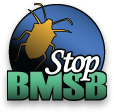- HOME
- » MANAGING BMSB
- » Behavioral & Landscape
- » Scientists Deploy Attract-and-Kill Trees against Stink Bugs
Scientists Deploy Attract-and-Kill Trees against Stink Bugs
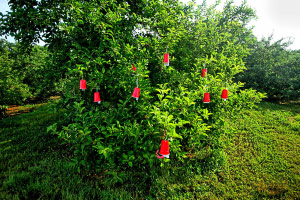 |
|
Attract-and-kill traps on a tree. Photo: Rob Morrison. |
It’s a kind of trap. The theory behind attract-and-kill is to lure pests such as insects to a precise location and kill them there. The point is not to have to spray an entire field or orchard, thus significantly reducing the amount of insecticide used, and therefore saving money and reducing risks of environmental side-effects.
Rob Morrison, a research entomologist with the USDA-ARS Center for Grain and Animal Health Research, describes a method for baiting select border-row trees with an aggregation pheromone of the brown marmorated stink bug (BMSB). The aggregation pheromone is the stink bug’s invitation to party. But then, film noir style, an insecticide kills them. The article was published recently in Pest Management Science.
While scientists having been working on applying this idea to BMSB for several years, the theory behind it goes back decades.
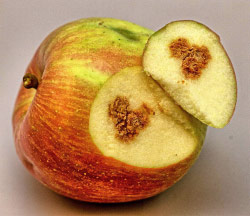 |
|
Damage to apple from brown marmorated stink bug. Photo: Rob Morrison. |
Successful Demonstration
“Damage to fruit harvested from baited attract-and-kill trees was high, but minimal in surrounding unbaited apple trees,” Morrison and colleagues wrote. Tracy Leskey, the entomology research leader and director at the USDA Appalachian Fruit Research Station in Kearneysville, West Virginia, was one of the leaders of the project. Morrison conducted research on the project while working as a postdoctoral research assistant in Leskey’s lab, and is the journal article’s first author.
The attract-and-kill strategy works against a pest known for causing sometimes catastrophic damage in sweet corn, peppers, tomatoes, apples, and peaches. BMSB has been documented causing big-time damage on the borders of fruit orchards. Nymphs (baby BMSB) can travel up to 65 feet in about six hours, and adults can fly an average of 1.5 miles in less than a day.
For attract-and-kill to work, you need to attract bugs to a tree en masse and keep them there for long enough that they drink the party’s Kool-Aid.
Scientists used a pheromone, in a low dose, that attracted bugs to an area of about the same the size as the area they attracted bugs to when using a high dose. This is important, because it means that bugs only gather in a small party zone—small enough to ensure that their rowdiness doesn’t spill over and cause damage on fruit in nearby trees.
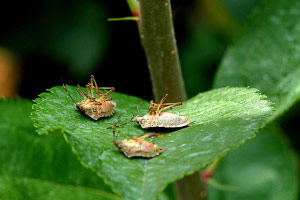 |
|
Dead stink bugs on an attract-and-kill tree. Photo: Rob Morrison. |
Economics Could Be Better
Morrison and his team have shown that attract-and-kill is effective at managing low to moderate H. halys populations, but must be optimized to increase economic viability for commercial growers.
There was less damage in attract-and-kill plots, but not enough to offset the additional cost of lures for the strategy.
The authors expect that the lure prices will come down in the future as manufacturing costs come down through greater production efficiency, and through optimizing the technique. The technique could be improved by having fewer attract-and-kill sites per orchard, less pheromone at each attract-and-kill site, or by having a sprayable pheromone that could dissipate as the effectiveness from the insecticide wears off instead of discrete dispensers.
“This study provides a proof-of-concept that attract-and-kill effectively works to manage an invasive and highly mobile pest,” Morrison said. “Once this tactic is optimized, I think attract-and-kill has the potential to significantly help rebuild the advanced IPM programs that were severely disrupted when BMSB became a problem for growers.”
New Technology: Nets and Radar
Using long-lasting insecticide netting in trees instead of sprays is showing promise. Basically, scientists bait trees with lure and set up traps made of insecticide-laced netting. If a threshold is reached in the traps, growers spray the orchard “alternate row middle,” basically spraying every other row, on one side.
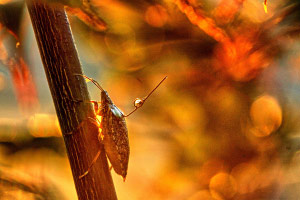 |
|
A tagged BMSB. Photo: Rob Morrison. |
As part of this study, Morrison tagged BMSB and reliably tracked them with harmonic radar. The tags look like a tiny antenna, glued to the back of the bug. It doesn’t interfere with the bug’s movement or behavior. Using this technology, investigators found, for example, that BMSB remain in a fruiting apple tree on average six times longer than on mowed grass.
The attract-and-kill method killed stink bug adults 180-fold more compared with controls.
Curiously, the aggregation pheromone seems to draw BMSB from a wider area than typical sex pheromones do moths.
The authors conclude that BMSB can be aggregated to spatially precise locations in orchards and removed through regular insecticide applications.
This provides an opportunity to revamp IPM programs, use precision agriculture by localizing management to specific sites, and preserving the natural enemies that can provide biological control services.
Image Gallery – Photos by Rob Morrison
Click on thumbnail image for a larger version.
